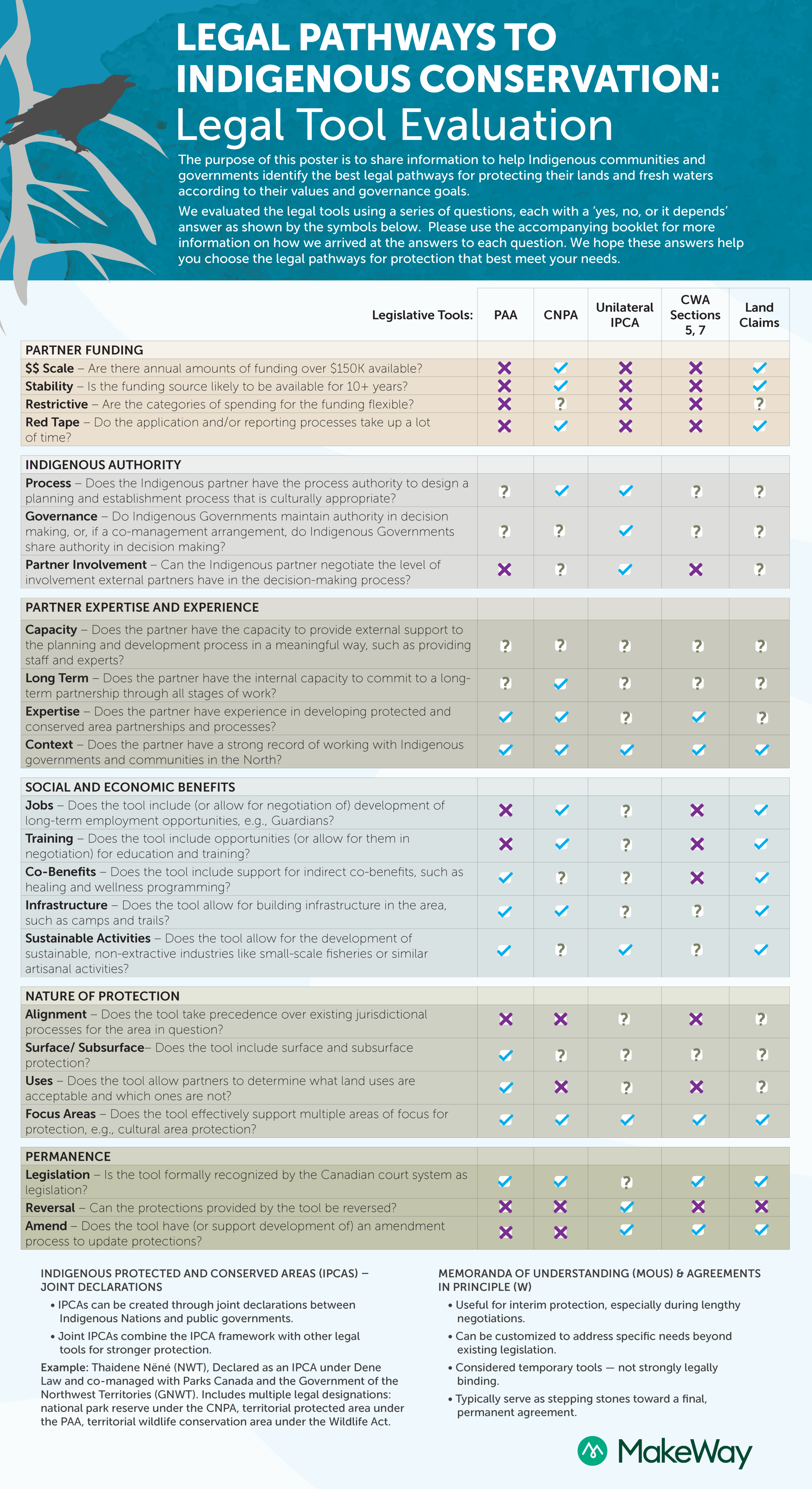Indigenous communities in the Northwest Territories are leading some of the most ambitious conservation efforts on the planet. Just look at NWT: Our Land for the Future—an innovative $375 million funding partnership for Indigenous-led conservation—or at projects like Thaidene Nëné, a 6.5 million-acre protected area rooted in Dene Law.
More than 20 Indigenous governments across the territory are now charting their own paths to create protected areas. Behind each project lie years of vision, careful planning, community engagement, and negotiation.
One of the most critical—and often complex—steps in this process is choosing the legal pathway that will protect these lands for generations to come.
“Currently, in Canada, a lot of the legal options for Indigenous conservation are provincial, territorial, or federal,” explains Steve Ellis, Northern Program Lead at MakeWay. “They are all imperfect and come with concessions for First Nations and Indigenous governments. Some communities are getting stuck exploring these pathways.”
Tailoring Conservation Support to Regional Realities
The idea for a region-specific tool to help Indigenous governments navigate their legal options emerged from an event Steve helped organize last year.
The Indigenous Conservation Forum was a three-day gathering in Vancouver that brought together members of more than 70 Indigenous Nations. Over 300 participants participated, sharing their knowledge and experiences in stewardship, governance, and conservation finance.
The event was the first of its kind—a uniquely Indigenous space that celebrated inspiring models of conservation leadership and trailblazing projects across the country. It also highlighted the regional diversity of projects.
“One of the main feedback elements that came out of the event was that it was awesome, but there’s such regional diversity and it would be good if there were follow up sessions focused on specific regions and their different legal and historical contexts.”
In the Northwest Territories, where Steve is based, there is growing momentum for Indigenous conservation, but figuring out the right legal pathway to protect these lands can be tricky.
“There’s a lot of funding and lots of organizations advancing projects, but the big bottleneck for Indigenous governments is that they’ve worked at the community level to figure out the areas they want to protect, but they get stuck trying to figure out the legal designation.”
The Legal Pathways for Indigenous Conservation
Communities can use a variety of legal pathways—and often combine several—to establish and support protected and conserved areas. These include Crown recognitions, such as the Canada Parks Act, which allows the federal government to enter into agreements with Indigenous communities to establish national park reserves; provincial or territorial laws; and unilateral declarations of Indigenous Protected and Conserved Areas (IPCAs), grounded in the laws and rights of an Indigenous government.
To help communities understand and compare the available legal options, MakeWay partnered with PlanIt North to develop an evaluation matrix. Each tool and governance model comes with its own trade-offs and considerations, making careful evaluation critical to long-term success.
“There’s no perfect tool,” says Steve. “People want permanent protection, which typically requires provincial, territorial, or federal laws. These are the laws our courts respect, but they come with trade-offs because they cede responsibility to Crown governments.”
It’s up to each Indigenous community and government to determine the legal pathway that best protects their lands in line with their values and governance goals—this is where the “Legal Pathways to Indigenous Conservation: Legal Tool Evaluation” can provide guidance.
“The idea for the tool was to go through all the existing legal options and evaluate them so that people would have a cheat sheet,” Steve describes.

Considerations for Selecting a Legal Pathway
Each evaluation metric included in the resource highlights a key factor that can influence the success, sustainability, and suitability of a given legal tool in achieving long-term, Indigenous-led conservation:
- Partner Funding: Whether the partner offers significant, reliable, and flexible funding and user-friendly funding applications and reporting.
- Indigenous Authority: Will the tool respect the Indigenous partner’s authority, including its authority to negotiate the level of involvement of external partners?
- Partner Expertise and Experience: Whether they have the capacity, availability, relevant experience, and proven track record to effectively and respectfully work with Indigenous governments and communities in the North.
- Social and Economic Benefits: Does the legal tool support employment, training, and the other co-benefits of protected and conserved areas important to the community?
- Nature of Protection: How well does the tool serve the community’s or Nation’s protection goals and align with their values?
- Permanence: Is the tool recognized by the Canadian courts and can the protections be reversed or amended?
Lessons and Innovations
In October 2025, MakeWay and PlanIt North hosted a two-day workshop in Yellowknife, bringing together about 30 participants to learn more about each of the legal pathways and the evaluation tool.
Participants also had a chance to hear about the experiences, challenges, and successes of different existing protected areas in the territory. With plenty of time for questions and conversation over the course of the workshop, attendees left feeling more confident in the tools and options available to them.

“The feedback was positive,” says Steve. “The tool did what it was supposed to do: demystify the different legal pathways at a glance.”
While the tool is specific to the Northwest Territories, he highlights that many of the legal pathways included are applicable in other regions, and the approach itself could be adapted and replicated elsewhere.
Although the tool outlines the potential trade-offs of current legal pathways, Steve points out that there are reasons to feel optimistic. “There’s a lot of innovation around legal tools now and potential new legal pathways for establishing Indigenous protected areas.”
As legal tools evolve to better meet community needs, Indigenous governments are actively exercising their authority to care for and protect their lands, choosing approaches that reflect their values, priorities, and aspirations. Along the way, they are showing one another what’s possible, highlighting the many creative, self-determined pathways forward to safeguard their homelands and support thriving communities.

